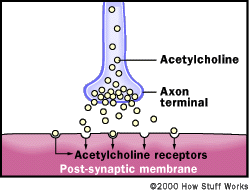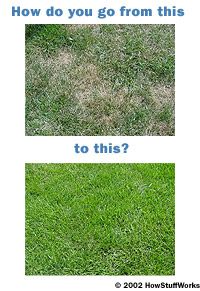Dursban is a product name for the chemical chlorpyrifos. Chlorpyrifos is one of the class of chemicals known as organophosphates. These are complex chemicals widely used as pesticides in agriculture. The U.S. Environmental Protection Agency (EPA) estimates that approximately 60 million pounds of organophosphates will be applied to approximately 60 million acres of crops in the United States this year. Dursban also has been used in pesticide sprays for residential and institutional use, including the sprays used by professional exterminators. In residential settings, chlorpyrifos have been used in termite treatments and lawn care. You will find other organophosphates in the pesticide section of your local home and garden center. Among the brand names to look for are Malathion and Diazinon.
Dursban, and the rest of the organophosphate insecticides, work by interrupting the electrochemical process that nerves use to communicate with muscles and with one another. A key chemical in communication between synapses is acetylcholine, a type of chemical called a neurotransmitter. This chemical is produced by the body, used to "fire" the neuron, and then is inhibited by an enzyme called cholinesterase.
Advertisement
Enzymes work by bonding with particular chemicals in a process often illustrated as a key going into a lock (see How Cells Work for details on enzymes). In a normally functioning nerve action, acetylcholine passes a signal (fires) between one neuron and another or between a nerve and a muscle receptor. Then cholinesterase binds to the acetylcholine, allowing the nerves to rest. Dursban alters cholinesterase, preventing it from inactivating acetylcholine. As the acetylcholine builds up, the muscles of the body become over-stimulated, leading to paralysis and death.
Organophosphates were first developed in the 1800s, but their effects on animals weren't discovered until the early 1930s. That effect was put to use in World War II, when organophosphates were used as nerve gas agents in chemical weapons. Dursban, and other organophosphates, are highly toxic to mammals, with a chemical characteristic that leads them to dissipate very slowly once introduced to the body. The symptoms of organophosphate poisoning start with extreme excitability and shaking, and move on to convulsions, paralysis and death.
So why doesn't Dursban affect the farmer when he's spraying his fields for insects? The answer is lethal dosage. Lethal dosages for most substances are based on the weight of the animal being given the substance. An adult human weighs far more than, say, a cockroach, so a dose of Dursban fatal to a bug will be below the level that has a noticeable effect on a human. Increase the dosage to a high enough level, though, and the substance that kills insects will have the same effect on humans. This is one of the reasons that lawn services warn homeowners to keep pets and children off the grass for a time after the lawn has been treated for insects: Since children and pets have lower body weights than adults, and tend to have their breathing apparatus closer to the ground, it's possible that they would receive a dose of insecticide sufficient to cause some effect, while adults are, in height and weight, "above" the level of toxicity.
The EPA has ordered the use of Dursban phased out in the United States. The pesticide has been removed from consumer retail shelves, and will be reduced to very specific commercial applications by 2002. The phase-out has been ordered primarily because of environmental concerns regarding mammals and marine animals, and to reduce exposure risks for children.
Advertisement


